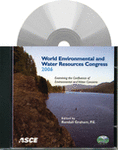The Utilization of Fly Ash for Sediment Stabilization during the Holmes Lake Restoration Project
Publication: World Environmental and Water Resource Congress 2006: Examining the Confluence of Environmental and Water Concerns
Abstract
Often the most difficult issue to address during the planning for the restoration of an urban lake is where to waste the vast amounts of sediment that will be excavated from the lake. In an urban setting, open space is limited and real estate values make it cost prohibitive to purchase land for wasting excavated sediment. Hauling the material to rural areas increases congestion of city streets and can also be cost prohibitive due to the long-haul distance. Furthermore, accidental dumping of sediment along with repeated heavy truckloads can significantly impact the design life of local streets, adding indirect costs to the option of hauling the sediment offsite. As part of the Holmes Lake Restoration Project in Lincoln, Nebraska, 330,000 cubic yards of deposited sediment were excavated across the lake bottom. Due to its urban setting and other site constraints, there were only eight acres of ground available for onsite disposal. The closest offsite location identified for disposal was more than six miles away, potentially adding significant transportation costs to the project. In order to waste the material onsite, the saturated sediment had to be stacked more than thirty-five feet deep. Consequently, the material had to be dried quickly and placed on steep slopes. Several conventional sediment management techniques were investigated for stabilizing the dredged sediment, but all were found to be ineffective. The utilization of a chemical drying agent was the only viable option remaining. It was determined that fly ash incorporation would be the most economical means of stabilizing the sediment from Holmes Lake. The use of fly ash during the Holmes Lake Restoration Project allowed the project to be completed in a timely manner and provided significant cost savings. Type ‘C' fly ash, a byproduct of coal combustion, was found to be effective in drying the wet sediment quickly. Furthermore, the fly ash added strength to the sediment, allowing it to be placed on steep slopes without the possibility of slumping or eroding back into the lake.
Get full access to this chapter
View all available purchase options and get full access to this chapter.
Information & Authors
Information
Published In
Copyright
© 2006 American Society of Civil Engineers.
History
Published online: Apr 26, 2012
ASCE Technical Topics:
- Ashes
- Bodies of water (by type)
- Construction engineering
- Construction management
- Construction methods
- Ecological restoration
- Ecosystems
- Engineering materials (by type)
- Environmental engineering
- Excavation
- Fly ash
- Infrastructure
- Lakes
- Materials engineering
- Project management
- Recycling
- River engineering
- Sediment
- Urban and regional development
- Urban areas
- Water and water resources
- Water management
Authors
Metrics & Citations
Metrics
Citations
Download citation
If you have the appropriate software installed, you can download article citation data to the citation manager of your choice. Simply select your manager software from the list below and click Download.
